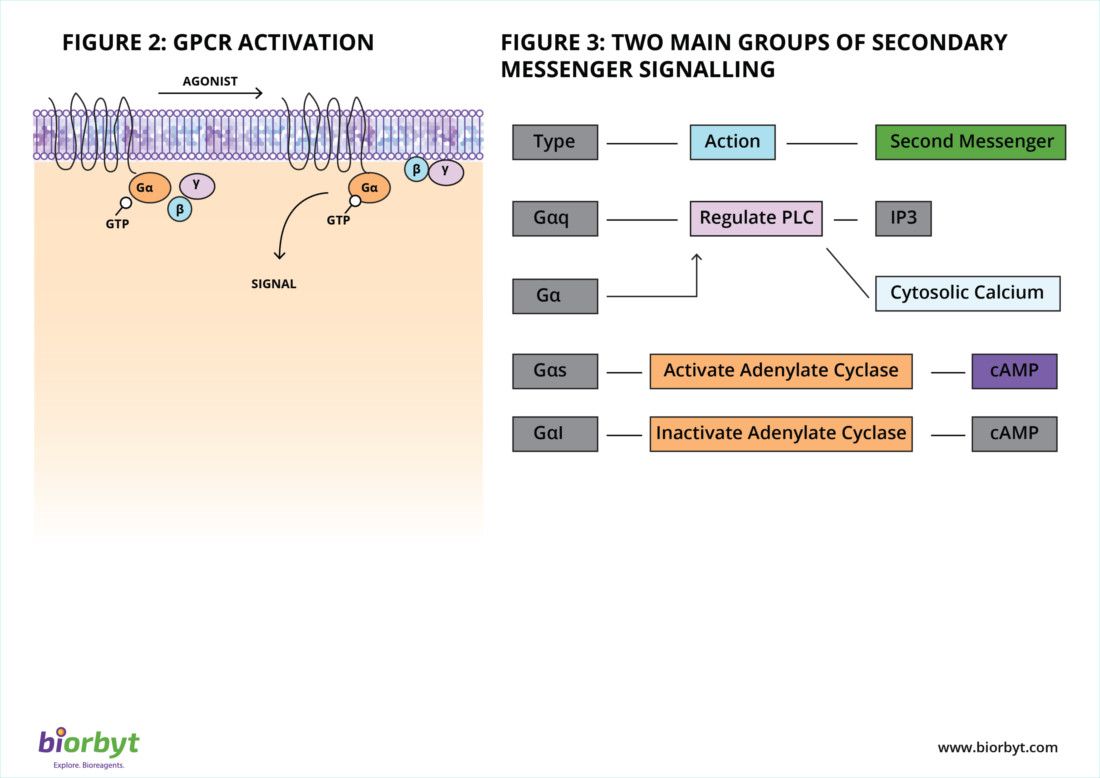GPCR Pathway
G-protein-coupled receptors (GPCRs) are the largest and most diverse group of membrane receptors in eukaryotes. G proteins are specialized proteins with the ability to bind the nucleotides guanosine triphosphate (GTP) and guanosine diphosphate (GDP). The G proteins that associate with GPCRs are heterotrimeric, meaning they have three different subunits: an alpha subunit, a beta (β) subunit, and a gamma (γ) subunit. Two of these subunits - alpha (α-) and gamma (γ) - are attached to the plasma membrane by lipid anchors (Figure 1). Ligand binding to the GPCR causes a change in the receptor conformation that in turn binds and activates the G-protein. The active form of the G-protein is then released from the surface of the receptor, dissociating into its α- and β/γ subunits. Both subunits will then activate their specific effectors, causing the release of second messengers. These messengers are recognised by protein kinases leading to their activation and triggering the signaling cascade towards a cellular event.

There are two main groups of second messenger releasing enzymes and both are activated or inactivated by different types of G-proteins (Figure 2 & 3). Subtypes Gαs and Gαi either activate or inactivate, respectively, the adenylate cyclase enzyme which converts adenosine triphosphate (ATP) into cyclic adenosine monophosphate (cAMP), releasing inorganic pyrophosphate in the process. Other subtypes such as Gαq or Gαo will alternatively activate the phospho-inositol phospholipase C enzyme (PLC), which hydrolyses phosphatidylinositol-4,5- biphosphate (PIP2) into sn-1,2 diacylglycerol (DAG) and inositol-1,4,5-triphosphate (IP3). The IP3 binds to an endoplasmic reticulum calcium channel, triggering the release of calcium ions into the cytosol.

GPCR function is associated with cell sensing of external factors including odorants, taste ligands, light, metals, neurotransmitters, biogenic amines, fatty acids, amino acids, peptides, proteins, steroids and other lipids. The large number of possibilities of ligands associated with the huge quantity of receptors has led to the association of GPCRs with a large number of physiological and pathological conditions. These include pain, asthma, cancer, cardiovascular diseases, gastrointestinal diseases, CNS diseases and others.
A Selection of GPCR Research Products
| Catalogue code | Description | Product Type |
|---|---|---|
| orb155530 | 5HT1F Receptor antibody | Antibody |
| orb72257 | 5HT1A Receptor peptide | Peptide |
| orb64030 | cAMP | Small Molecule |
| orb95030 | CREB1 antibody | Antibody |
| orb29949 | AKT antibody | Antibody |
| orb134466 | Fluocinonide(Vanos) | Small Molecule |
| orb101191 | GPR55 antibody | Antibody |
| orb157371 | GPR92 antibody | Peptide |
| orb440593 | Human LPAR3 ELISA Kit | ELISA Kit |
| orb393286 | FFAR2 antibody | Antibody |
Helping your research
Biorbyt has an extensive range of small molecules available as research reagents to target proteins in the GPCR pathways. We provide the best service and a simple buying process allowing you to focus on your valuable research. Take a look at our product pages where you will find competitive pricing, lead times, and easy delivery options. If you have any questions, just ask us.

